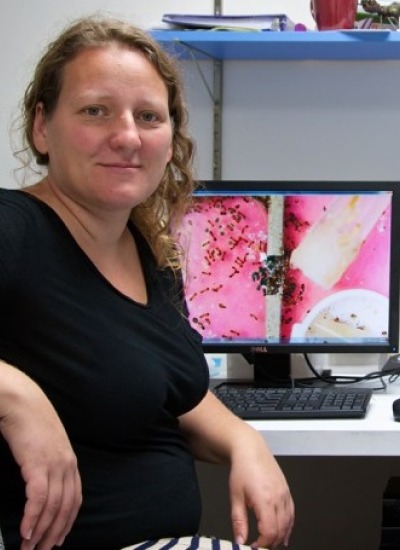Anna R Dornhaus
Publications
Social insect colonies are complex systems in which the interactions of many individuals lead to colony-level collective behaviors such as foraging. However, the emergent properties of collective behaviors may not necessarily be adaptive. Here, we examine symmetry breaking, an emergent pattern exhibited by some social insects that can lead colonies to focus their foraging effort on only one of several available food patches. Symmetry breaking has been reported to occur in several ant species. However, it is not clear whether it arises as an unavoidable epiphenomenon of pheromone recruitment, or whether it is an adaptive behavior that can be controlled through modification of the individual behavior of workers. In this paper, we used a simulation model to test how symmetry breaking is affected by the degree of non-linearity of recruitment, the specific mechanism used by individuals to choose between patches, patch size, and forager number. The model shows that foraging intensity on different trails becomes increasingly asymmetric as the recruitment response of individuals varies from linear to highly non-linear, supporting the predictions of previous work. Surprisingly, we also found that the direction of the relationship between forager number (i.e., colony size) and asymmetry varied depending on the specific details of the decision rule used by individuals. Limiting the size of the resource produced a damping effect on asymmetry, but only at high forager numbers. Variation in the rule used by individual ants to choose trails is a likely mechanism that could cause variation among the foraging behaviors of species, and is a behavior upon which selection could act.
Abstract:
Many ant species are polydomous, forming multiple spatially segregated nests that exchange workers and brood. However, why polydomy occurs is still uncertain. We investigated whether colonies of Crematogaster torosa form new polydomous nests to better exploit temporally stable food resources. Specifically, we tested the effect of food presence or absence and distance on the likelihood that colonies would form a new nest. Because this species also forms little-known structures that house only workers without brood (outstations), we also compared the function of this structure with true nests. Laboratory-reared colonies were connected to a new foraging arena containing potential nest sites with or without food for 4 months. When food was present, most colonies formed polydomous nests nearby and the remainder formed outstations. When food was absent, the behavior of colonies differed significantly, frequently forming outstations but never polydomous nests. Distance had no effect on the type of structure formed, but when food was present, a larger proportion of the workforce moved shorter distances. Workers often fortified the entrances to both structures and used them for storage of dried insect tissue ("jerky"). In an investigation of spatial fidelity, we found that workers on the between-nest trail were associated with the original nest, whereas workers collecting food were more likely to be associated with the new nest or outstation. C. torosa appears to have a flexible colony structure, forming both outstations and polydomous nests. Polydomous nests in this species were associated with foraging and were only formed near food resources. © 2010 Springer-Verlag.
Abstract:
Colony size can affect individual- and colony-level behavioral and physiological traits in social insects. Changes in behavior and physiology in response to colony growth and development can affect productivity and fitness. Here, we used respirometry to study the relationship between colony size and colony energy consumption in Temnothorax rugatulus ants. In addition, we examined the relationship between colony size and worker productivity measured as per capita brood production. We found that colony metabolic rate scales with colony size to the 0. 78 power and the number of brood scales with the number of workers to the 0. 49 power. These regression analyses reveal that larger ant colonies use proportionally less energy and produce fewer brood per worker. Our findings provide new information on the relationships between colony size and energetic efficiency and productivity in a model ant genus. We discuss the potential mechanisms giving rise to allometric scaling of metabolic rate in ant colonies and the influence of colony size on energy consumption and productivity in general. © 2012 International Union for the Study of Social Insects (IUSSI).
Abstract:
Body size is often positively correlated with ecologically relevant traits such as fecundity, survival, resource requirements, and home range size. Ant colonies, in some respects, behave like organisms, and their colony size is thought to be a significant predictor of many behavioral and ecological traits similar to body size in unitary organisms. In this study, we test the relationship between colony size and field foraging distance in the ant species Temnothorax rugatulus. These ants forage in the leaf litter presumably for small arthropod prey. We found colonies did not differ significantly in their foraging distances, and colony size is not a significant predictor of foraging distance. This suggests that large colonies may not exhaust local resources or that foraging trips are not optimized for minimal distance, and thus that food may not be the limiting resource in this species. This study shows T. rugatulus are behaving in ways that differ from existing models of scaling. © 2012 International Union for the Study of Social Insects (IUSSI).


